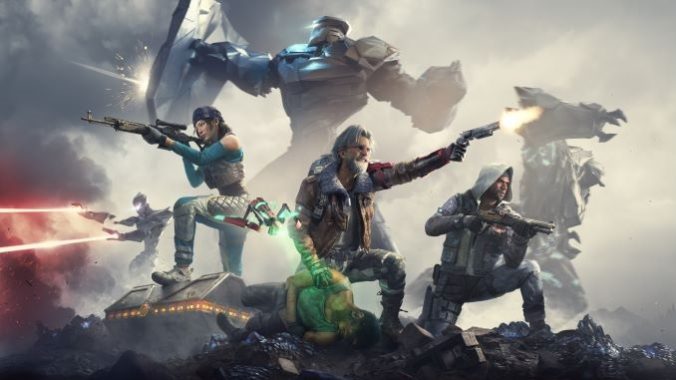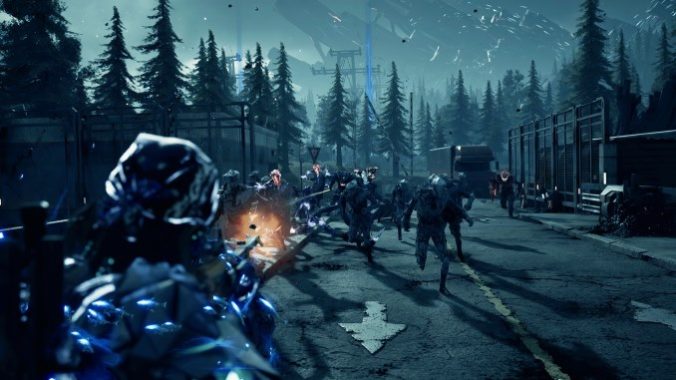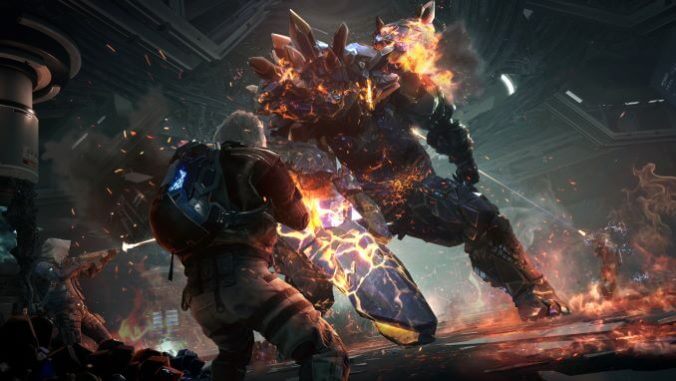
SYNCED wants to be your next everything. It’s got it all: it’s a third-person run-based cooperative looter shooter with classes. It’s got a PvE component where you and two other players drop into zones, fight through progressively fierce waves of enemies, and are ultimately showered in rewards, often equating to guns you’ll equip the next time around. These guns range from the mundane and basic to the alien and extravagant, like a black hole gun. There are plenty of classes tied to unique characters that have abilities you can use, like a medic with a healing aura and a guy who’s especially handy with crowd-controlling grenades. If you’ve picked up a multiplayer game in the last decade, this all sounds intensely familiar. As someone who can’t help but keep picking up these kinds of games, I enjoyed my time with SYNCED because of how familiar it was, but that’s also exactly why there are concerns to be had.
The online service game bubble popped in the early months of 2023, culminating in the shuttering of a dozen games and counting this year. Though the bloodletting has slowed, or just grown quieter among the endless noise, the threat of an imminent and swift death hangs over these titles like a plague. It’s in the air. SYNCED has a tall order ahead of it then. Not only does it need to differentiate itself from the pack enough to stick out, but it needs to be able to sustain that for long enough to avoid joining a growing list of casualties.
On its surface, SYNCED has a hard time standing out. The whole time I was playing the game, I couldn’t help but remark to colleagues at our preview event how much it felt like other titles I’d recently played. Though I was likening it to its contemporaries in an entirely complimentary way, the comparisons between SYNCED and games like Remnant 2 began stacking against the former rather than in its favor. The game is situated in this resurgence of sorts among cooperative (specifically three-player co-op) games that’s a welcome blessing for people like me who have exactly two other people they actually enjoy playing games with, but locks it into stiff competition. To SYNCED‘s benefit, it makes the most of the talent behind it. Another free-to-play game might’ve felt cheaper, but SYNCED has just the right amount of weight and responsiveness that makes for a satisfying shooter. But this alone can’t carry the game.

Nor do the developers at NExT Studios expect it to. SYNCED is set in a near future where an alien nanotechnology we helped proliferate has turned on us. The morose intro to the game’s tutorial sets the stage for a grand collapse of society before quietly shunting us some years later. We pick back up as Runners, folks who risk their necks traveling into dead sectors for valuable technology, weapons, and other resources like Radia. Their lives are forfeit in these sectors because nanotechnology has essentially created itself an army (think robot zombies) which occupy the Meridian, where most of SYNCED‘s action takes place. Aside from the rank and file Nanos, there are special Prime Nanos that can be domesticated once defeated and turned against their own. Here at last, SYNCED begins feeling like its own game.
The Prime Nanos come in different shapes and sizes. When you’re deploying into runs—there’s no formal campaign or series of missions to complete in SYNCED—part of the loadout that you’ll be selecting will be these Nano companions, who can vary from the hulking Crusher to the zippy recon-heavy Seer. Each has their own active and passive skills and they’re summonable with a single button press at almost any time. Though my early missions were never so trying that I felt forced to rely on them, summoning always immediately turned the tide of a battle, which I can see obviously coming in handy on harder runs in the endgame, future bosses I didn’t get to experience, and PvP. They also each come with a different method of movement: double-tapping the jump button allows the character to perform a Nano-assisted superjump of sorts. One form lets you fly forward with a jetpack for a short burst, while another lets you flip in the air and land on a board reminiscent of the Silver Surfer. It’s mostly for flair, but flair means everything in games like this.
As it stands, what sparse story there is to be told comes through in the game’s PvE component, where players craft loadouts in a base called Haven (which looks and feels entirely like the Farm from Destiny 2) before going on runs. Runs consist of picking a dead sector—in our build we were max level and had access to all of them as well as a higher tier of endgame activities—dropping into the area and then shooting your way through waves of Nanos taking out what are called Surge Storms. These are essentially concentrations of enemies with a miniboss thrown into the mix. The progression of these levels is kind of freeform: you’re free to explore the length of the battlefield at your own pace, picking up materials to use at vendors and stations that provide temporary upgrades. These upgrades can increase your armor, the power of your weapon, or give you neat perks like ricocheting bullets and exploding enemies before going away at the culmination of a run. Use these to clear a stage of the dead sector before moving to the next one and then the one after that, completing similar goals until you defeat the final boss and get to triumphantly return with your loot and a slew of permanent perks you’ll often pick up along the way. The structure of these is great if you have, say, an hour or two every few nights to play this game, because they allow you to immediately drop into action and come out the other side feeling like you’ve gone through a whole ordeal. To anyone playing more regularly—and let’s be clear, most folks who play service titles like this tend to fall into the mindless grind—I daresay you might exhaust SYNCED‘s options more quickly than you think.

PvP doesn’t fare too much better. In its initial announcement, and under a slightly different name, SYNCED seemed to be a different game than what we ended up getting. Those early glimpses suggested that players would be one squad in a series of them all occupying one map a la PvPvE experiences like The Division series Dark Zones or Escape from Tarkov. Even hazarding a look at the earliest gameplay reveals a game of a different tempo and temperature. It’s like if an indie mood piece came back as a summer blockbuster years later. Similarly, SYNCED appears to be a radically different game, taking the time between its announcement and reemergence to be fundamentally reworked, though this could just be conjecture on my end. PvP feels born from that initial blend being hacked to pieces, pared back, and then siloed off to create distinct aspects of a whole game, perhaps because it just didn’t work altogether or because someone said the unified experience didn’t have enough meat on the bone. It doesn’t work perfectly apart either though. PvP, which we played as a free for all between a handful of human players and some AI, functions like a clunkier extraction shooter. You go around mowing down Nanos and players who get in your way until they run out of lives, all the while you’re building a stockpile of resources that function as your score. Whoever emerges at the top or makes it out with the highest score wins, but the mode was far too slow going to ever really impress or dazzle. It’s just kind of there.
When taking into account either mode, you could kind of make out how either might’ve complimented the other. The PvE has the mindless cannon fodder you can punch a hole through without even thinking, but could use the injection of tension of an enemy squad of players suddenly getting on the drop on you. The PvP, which features far fewer AI enemies in an attempt to force conflicts between players, could benefit from the pressure of endless waves to make for more frenetic and thus dynamic fights. Instead, they exist as disparate elements of a game that might’ve been better had they been smashed together.
SYNCED is bound to find its people, but I worry for how long. It obviously shows promise in the quality of what’s on the screen, but I reckon that in 2023, it’s not enough to simply look and feel good. Lesser games have found their footing, but at a time like this, you wonder if it isn’t too wise to gamble with a project this big. Then again, if you want to be everything to everyone like this game does, it’s hard to argue with the approach here, even if it begs for some refinement or a clearer vision.
Moises Taveras is the assistant games editor for Paste Magazine. He was that one kid who was really excited about Google+ and is still sad about how that turned out.